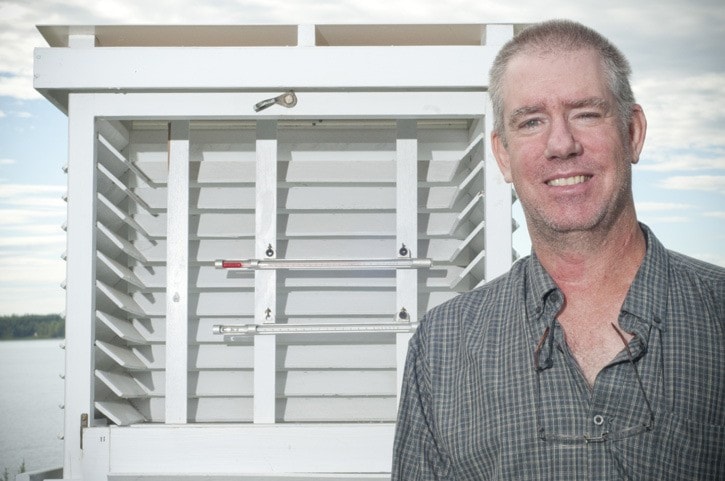Thanks to the efforts of one man especially, the oldest operating weather station in the province will keep on measuring local temperatures.
Since 1895, people have been measuring temperatures in Fort St. James. Originally, the measurements would have been taken from the site where the office of Ecofor now sits, and over the years, while the location moved around a bit, it was still in the same general location at the end of the lake.
In 1965, Grant and Marianne Luck began taking care of the station, which was then located on the Sowchea side of the lake, near Pitka Creek.
The station was later moved to the Luck’s own property, on Grant Road, and until October of 2010, it remained there, where the Lucks took daily readings for Environment Canada, and finding someone to fill in for them when they were away.
Anthony Fast, a Registered Forest Technologist, found out about the station. Fast takes a particular interest in the local weather changes thanks to his position at BC Timber Sales (BCTS), where he is in charge of the tree planting contracts in the area.
Fast was interested to see it, and so he visited the Lucks, who were getting a bit tired of having to monitor the station daily, and were looking to potentially pass it on to someone else.
Fast was already considering the possibility of relocating the station to the B.C. government ministry building on Stones Bay Road.
“I thought, why not check and just see if we can move it over here,” said Fast.
After conversations with his supervisors, who supported his idea, Fast went to Environment Canada, who also were in agreement.
And so the weather station now lives on the shores of Stuart Lake again, but 3.5 km from its last location on Sowchea.
With Environment Canada now subject to deep cuts by the Harper government, the weather station would quite likely have been phased out once the Lucks gave up monitoring it, according to Fast. Fast has taken on the monitoring for free, and now monitors the station twice daily Monday to Friday.
The weather station itself is an unassuming site, made up of a small square structure, a rain gauge for the summer and a board for the winter to measure snow depth.
The square wooden structure is painted white so it doesn’t absorb extra heat, and baffled to reduce the effects of wind on the gauges inside it, there are just two thermometers inside.
One thermometer is a mercury thermometer which measures the high temperature of the day.
After a reading is taken, Fast shakes down the liquid mercury again, to reset the instrument.
The second thermometer is an alcohol thermometer, which contains a small bar, which is pushed down as the alcohol drops, marking the low temperature over the measured period.
Snow depth is measured as accumulated (the snow packs down as it piles on top of itself and temperatures change the crystals) and as daily, one measured on a board on the ground, one measured from the roof of the thermometer box, which is cleared off after each measurement is taken.
Because Fast only works Monday to Friday, he takes readings twice a day on those days, and with the help of his coworkers, Cindy Holland and Paul Inden, the weather readings for the Fort area still continue.
The readings are entered into an Environment Canada database, and readings and temperatures can be accessed online via their website as far back as readings began.
On the day of writing this, September 8, in 1895, the high temperature for the day was 5.6 degrees Centigrade, the minimum was -1.7 and 7.9 mm of rain and 0.5 cm of snow fell.
While Fast’s interest in climate is a bit unorthodox (he believes our carbon dioxide contributions to the atmosphere are not as much the cause of changes in climate as changes from the sun) his interest has meant the Fort’s long tradition of weather monitoring can continue.
To have a look at historic temperatures or precipitation data, go to the National Climate Archive and click on customized search, then search by station name using Fort St. James and enter the year or date you would like to see.
